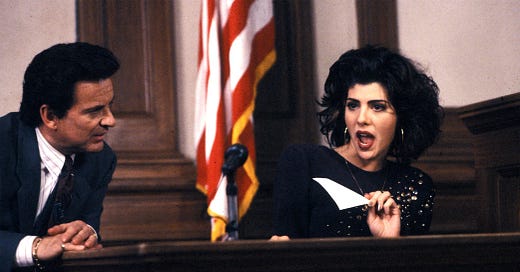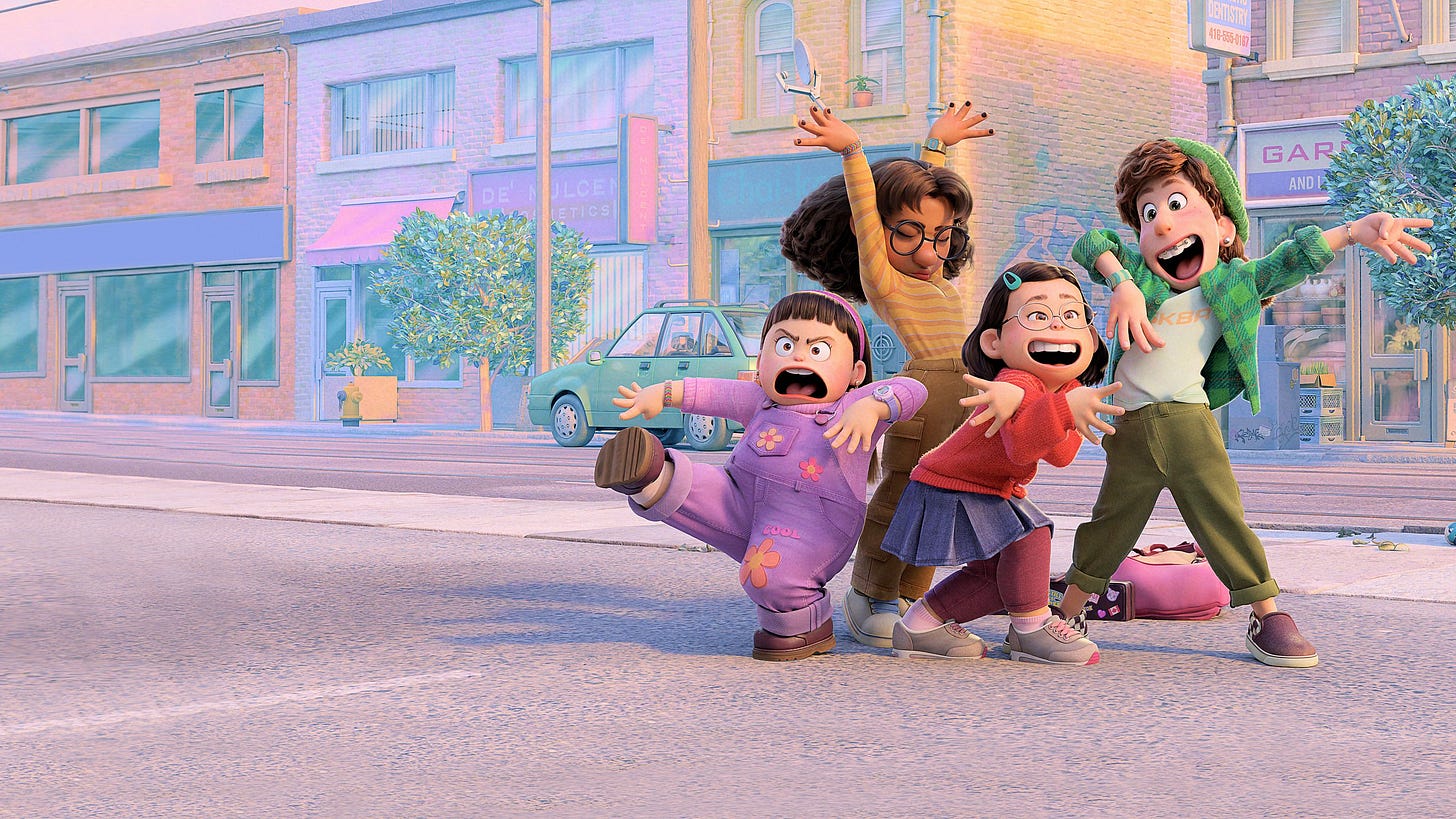We’ve been out of your inboxes for a while — what can we say, we’re eating the summer up before it’s even officially here. But before we head out on our official Summer Break, we have two brand new issues coming your way.
This week, we’re talking about people who cut through the bullshit and find something better. First, from Zosha, on the magic of Marissa Tomei in My Cousin Vinny. Then, Cate on the deeply mature message of Turning Red. And next week, we’re heading into sequel territory, so stay tuned. Have a read, and do enjoy. Happy movie yelling!
Zosha on My Cousin Vinny
No one will be surprised to hear that My Cousin Vinny is about finding out the truth. It’s practically the name of the game: Two boys roll through a small Alabama town, accidentally shoplift, think they’ve been arrested for accidentally shoplifting, only to find out that they’re actually booked for the murder of the shop clerk with what seems like some watertight evidence. Upon their arrest, one of the boys’ mothers summons his cousin Vinny, six weeks fresh off passing the bar and hungry for his first real case.
It’s a modern classic, for the reasons that it is funny and charming and kooky and manages to be all these things well while also being kind of neatly poignant. Vinny (Joe Pesci) is neither a full caricature of a Brooklyn bombast, nor not engaging those stereotypes in a semi-real way. He’s also not impregnatable, as we watch him grow and learn while showing some of his natural smarts all along the way. The movie is Pesci’s, he’s playing the titular character. And yet, I’m here to talk to you about Marisa Tomei’s Mona Lisa Vito.
Again, not a surprise! She won an Academy Award for Best Supporting Actress; this is not a role that went unmentioned in the year of its release (1992), nor has it been unsung in the years since. It’s right there at the top of the Wikipedia page, next to the mention that lawyers have lauded the movie for its courtroom procedure. But on a recent rewatch, I found myself interested again in how much her performance captures the greatness of the movie.
On paper, Mona Lisa is pure stereotype, and in a way that reads a little opaque for the rest of the film. Like her fiancé, she’s brash and bold, and it often comes out as if she’s nagging Vinny — pointedly asking him if he knows what he’s doing, or if he heard what the judge said. She’s astute but openly lets someone fleece her for one of their traveler’s checks. Her brassy nature seems at odds with her presence in Alabama. And yet, Mona Lisa is more than that. She’s smart as hell, attempting to be helpful, and (perhaps best of all) leveling with Vinny at every turn. Sometimes she harps on Vinny because she’s actually seeing something he isn’t; sometimes she makes mistakes because she has her own point of view and is trying to make sure he understands that. She wears incredible outfits because, well, I mean, look at her.
The beauty of the role is that the movie not only understands her importance, it hinges on it. Tomei’s performance is fabulous — she draws out the humanity underlying every badger, making it clear in every scene that Mona Lisa is not some hanger-on — but it’s also merely the rendition the role demands. I don’t think My Cousin Vinny wants you to think of her ever as solely as Brooklyn bitch, but it certainly plays on those ideas. But for her to be someone Vinny wants to impress (rather than merely placate) she has to be worthy, and ultimately she is. Not just because she helps him win his case, or stays in love with him, or what have you — it’s because she just feels like an actual person among all the stereotypical flotsam that makes up her character in the beginning.
In the end, Mona Lisa and her encyclopedic knowledge of cars ends up being integral to the chicanery of the trial. But her story radiates past any mere trial victory. In a story that’s all about finding the god’s honest truth through sussing out facts and figures, arguing, and navigating the mundane bullshit making up all of our lives, Mona Lisa is It. The rest of the movie, unsurprisingly, is just trying to get on her level.
Cate on Turning Red
They say that the key to connection is specificity. And nowhere is that more apparent than with Pixar’s latest feature Turning Red. Directed by Domee Shi — best known for her short film Bao — Turning Red tells the story of one Chinese-Candian girl’s experience with magical puberty.
In the film, Meilin Lee (Rosalie Chiang) is a plucky, confident 13-year-old in 2002. She excels at school, loves her friends, and enjoys teaming up with her strict mother to take care of their family temple. But when a family birthright turns her into a giant red panda overnight, Meilin has to figure out how to navigate growing up, becoming her own person, and finding peace with her family’s legacy.
The magic of Turning Red is how deeply it knows and understands Meilin. Her life and experiences are so detailed and tailor-made for a girl in her time. From her budding lust that forms around the members of her favourite boy band, to the star-sticker earrings she wears to school, the film had created a full and fleshed-out character upon which to hang its narrative.
And that hard work pays off. Turning Red uses the many facets of Meilin’s personality to explore issues like puberty, family lineage, generational trauma, and the need for individuality within a more community-minded culture. When Meilin reveals her panda to her mother Ming (Sandra Oh), she tells her that “their little family inconvenience” is something that must be hidden away and kept a secret. The framing of this new reality immediately imbues Meilin with a sense of shame. Her body is changing, and it’s not a good thing. But when Meilin reveals her panda to her friends and classmates, she discovers that they don’t think it’s shameful at all. In fact, they love it, and their enthusiasm leads Meilin and her friends to a pretty tidy profit.
What Meilin doesn’t know, however, is that Ming’s own panda is a source of immense shame for her. Once when she was younger, Ming injured her mother Wu (Wai Ching Ho) when she unleashed her panda in anger. Because of this, Ming feels very strongly that the solution for Meilin is for her to suppress her panda. And Meilin struggles with her desire to be herself and her fear of losing her mother’s approval.
But the film is unsubtle about the fact that Meilin’s panda is her source of power. Despite her mother’s warnings, Meilin has found her skill and confidence through her experiences with her panda. She becomes more of herself than she ever was before. Her panda is a part of her.
Meilin’s decision to keep her panda — despite the family ritual to lock it away forever — shows us her coming into her own as a person separate from the people who made her. She understands and empathizes with her family’s decision to isolate their pandas. But she wants hers to be free. She wants her panda to be part of the full self she is growing to be.
Ming and Meilin’s ability to come to terms with Meilin’s decision gives us a look at the potential we mine when we face the demons that stalk our pasts. Mothers pass on anxiety and worry to their daughters. And daughters, in turn, internalize shame. Turning Red rejects this progression of events as a birthright, and allows Meilin the agency to choose her own path and lean into the difference that makes her special. It’s a truly stunning execution of a much-needed message.
Turning Red touched me in a way no movie has in a long time. Meilin would be my age, and the connection I felt to her was on a near-spiritual level. Visions of Backstreet Boys dance-offs and sticker-covered notebooks filled with doodles of “Mrs. Nick Carter” came flooding back to me. Meilin is me. I only wish I had a heroine as cool, self-assured, and sassy when I was still our age. Domee Shee has given Disney/Pixar a heroine they should be proud of, and I hope there will be more like her soon.
Assorted Internet Detritus
ZOSHA: The five-minute nostalgia cycle. A fantastic not review of The Stanley Parable release. Ellen’s show is over and what happened to get us (her) here? Reconsidering the one-hit wonder! And I wrote about how Prehistoric Planet kicks off with the GOAT (underwater dinos) and how the Halo show never gave a shit about aliens.
CATE: Revisiting the finale of Lost, how true crime adaptations can fail real-life victims, the power of teen girl fandoms, the last sad girl alive, about that Bechdel test dustup, on the importance of mangoes, how P-Valley is handling the pandemic, a Purl spark short to start your day, the limits of “cottagecore,” how a group of women unraveled a mystery, and what female pleasure onscreen tells us about ourselves.
If you’re just finding this newsletter, do us a favour and subscribe. It feeds our fragile egos. And if you’re already a loyal reader, help us out and tell a friend. For Issue #69 next week, we’re talking Top Gun: Maverick and Jurassic World: Dominion. Gird your loins, and happy movie yelling!
Zosha + Cate <3
twitter:@30FlirtyFilm
instagram:@30FlirtyFilm









